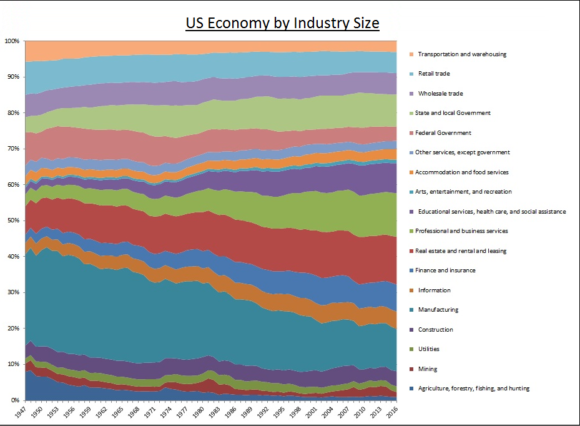Donald Trump made a big stink at the G-7 this past weekend because he refuses to understand the simple reality of the US trade situation and insists on promoting a populist trade position that makes little sense. I’m gonna keep this real simple so bear with me for a second.
The USA runs a trade deficit with most other countries in the world. This means we import more than we export. Whether this is “good” or “bad” depends on lots of factors. For instance, when I go to the grocery store I trade money for food. I run a deficit with the grocery store and I run a temporary food surplus. Is that bad? No. It’s just a trade. And depending on which side of the trade you’re on it might be viewed as good or bad. That is, after all, why we call it a “trade”. Both sides get something they want.
There’s nothing inherently bad about a trade deficit. It doesn’t mean one side is winning and one side is losing. But understanding why one side has a deficit and the other has a surplus is an important part of understanding this discussion and whether it can be fixed with changes to trade policies.
Now, the main reason the USA runs a trade deficit with countries like China is because it’s much cheaper to make stuff in China than it is in the USA. A factory worker in China commands just $3.60 per hour versus $23 in the USA. US workers command higher wages because there are fewer workers and those workers demand higher wages to meet their higher living standards. The inverse is true in China where living standards are lower and there is an abundance of labor.
When multinational US corporations decide where they’re going to make their goods they can either choose the $23 worker in the USA or the $3.60 worker in China. In the last 30 years more and more companies are choosing the $3.60 worker in China because that results in higher relative profits in the USA. But the thing that many people don’t realize is that when those goods are made in China they are often reported as imports into the USA. So you have US companies selling US products that are made in China and reported as imports in many cases.
Of course, you might say that US workers are worse off because they have lost their jobs to the Chinese workers. This is true in some sense and wrong in another sense. When US corporations make their goods in China they are then able to sell those goods at much lower prices in the USA. So while some workers are worse off the larger consumer base is better off since the benefit to the US consumer is that they get the cheaper goods AND they have more money to spend elsewhere. Importantly, this results in demand in other parts of the economy which leads to job growth in other segments of the economy. Here’s a chart of this redistribution of demand across the economy as US manufacturing has become a smaller part of the pie and other segments have offset that decline:

So let’s say we want those jobs to come back to the USA and decide that raising prices on China’s exports is a good way to do that. Well, what really happens there? In short, you and I end up paying higher prices for all of those goods sold in the USA because corporations will pass on the costs to their consumers. And if they decide to bring the jobs back then all those goods are now being made by a $23 worker which results in the same price increases to the end consumer. In either case, this raises the cost of things like iPhones and reduces the amount of money we have to spend in other parts of the economy. Yes, it makes some workers better off, but it makes most of us worse off.
Now, Trump and his team think that making those imports more expensive is a good deal because Americans will then buy American produced goods which will increase the number of American workers building those goods. But the more likely outcome is that those jobs never come back because companies like Apple won’t just bring those jobs back to the USA – they will move them to places like Vietnam because they have to protect their profit margins.
The bottom line is it costs more to build stuff in the USA because we are better off than many other regions of the world. And by outsourcing the production of many goods and services we make some workers worse off while making those products cheaper for everyone in the USA. This is a good trade for a country where prices are inherently higher. Raising prices on these goods via tariffs doesn’t fix the problem it tries to solve and won’t lead to a trade surplus or fairer trade. In fact, it just results in higher costs for US consumers which makes most of us worse off.
NB – One result of increasing globalization is that more of national income has flowed to corporations which has led to higher inequality. But again, inequality is a problem that tariffs won’t fix. Unfortunately, much of the populism we are seeing today seems to be aimed at globalization when it should be aimed at inequality.
Mr. Roche is the Founder and Chief Investment Officer of Discipline Funds.Discipline Funds is a low fee financial advisory firm with a focus on helping people be more disciplined with their finances.
He is also the author of Pragmatic Capitalism: What Every Investor Needs to Understand About Money and Finance, Understanding the Modern Monetary System and Understanding Modern Portfolio Construction.

